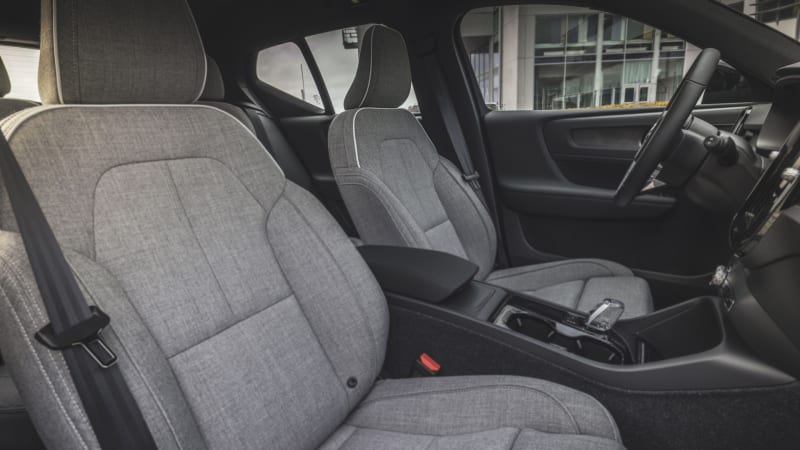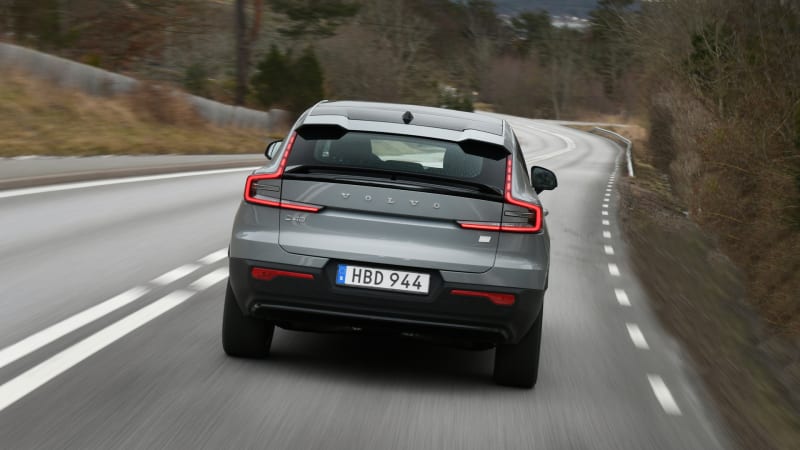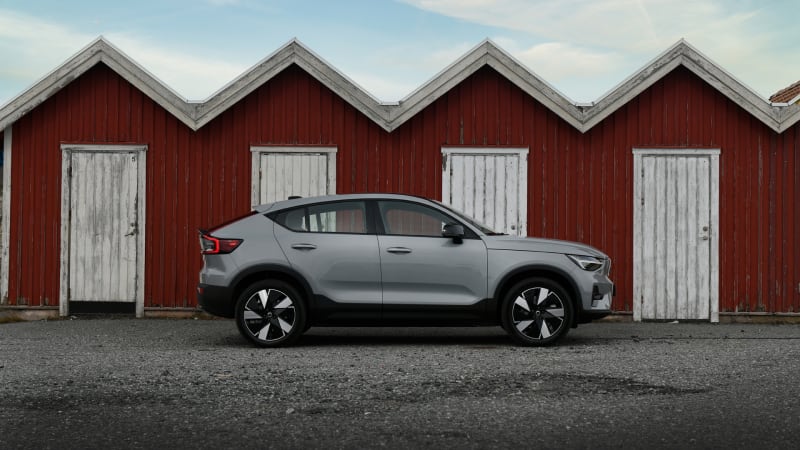The 2024 Volvo XC40 Recharge and C40 EVs will be available with rear-wheel drive, replacing the front-wheel-drive version that has been the fraternal pairing’s single-motor base model. This is obviously newsworthy — why else would I be writing about it? But does it actually mean anything? After driving both of these vehicles around the lakes, seaside, perfectly-maintained highways, and cobblestoned urban streets proximate to the brand’s headquarters in Gothenburg, Sweden, I can say that the answer is, not really. But that’s not really Volvo’s fault.
The last time Volvo sold a rear-wheel-drive vehicle in the United States was 1998 when the cushy, brick-like 960 was retired (officially S90 and V90 in their final year). Everything thereafter was front-wheel drive or at least on a front-drive-based platform, in no small part due to the additional all-weather traction and stability afforded by the additional weight of an internal combustion engine and transaxle over the drive wheels. In short, it was safer, and even as Volvo moved away from decades of arcane, rectilinear design, safety remained its raison d’etre.
That hasn’t changed, but according to Volvo, EVs have fundamentally changed vehicle dynamics, centers of gravity, and weight distribution to refute the front-drive argument.
A Volvo spokesperson told me that this new one-motor layout in the XC/C40, driving the rear wheels, with contemporary advanced driver assistance systems, is better in inclement weather than a gas-engine/FWD combo.
That explains why the switch to a standard rear-drive layout doesn’t run afoul of Volvo’s established ethos, but why make the switch in the first place? Whether it was the plan all along, or just an advancement of next-generation technology to prolong and extend the relevance of these vehicles, is not something Volvo would comment on. In any event, many of the base EVs that are in or near the XC/C40’s competitive set — the VW ID.4, the Kia EV6, the Hyundai Ioniq 5 — feature rear-wheel drive in their single-motor setup. It is notable that all of those cars were developed from the ground up as EVs and could be optimized for the aforementioned dynamics. The XC40 and C40 were built on a platform capable of accommodating gas-only, plug-in hybrid and full-electric powertrains.
It’s also important to note that with this switch in standard layout comes new motors, which may have something to do with the switch. They were also developed in-house, optimizing Volvo’s efficiencies, rather than purchasing its needs from a supplier. This is not something a carmaker does with a part they are using simply to extend the life of a vehicle nearing replacement.
This new rear motor is thus likely to find other uses down the line. Volvo spokespeople would not comment on future product offerings, but I would hazard to bet that versions of this motor mounted to the rear axle will proliferate through the Volvo range as its pure electric offerings expand in its next generation(s) of vehicles. (Volvo has promised to build only battery-powered passenger vehicles by 2030).
We didn’t really have a chance to put Volvo’s dynamic traction promise to the test. Though Gothenburg is known for providing cheerless spring murk and drizzle, our time in Sweden’s second city was glorious, with 16 hours of daily sunshine. There wasn’t all-weather traction needed, anywhere. Too bad.

We still got a chance to try both the rear-drive powertrain and the equally new twin-motor, all-wheel-drive version. Instead of the previous setup of identical 150-hp motors on the front and rear axle, a 255-horsepower version of the new rear motor is joined by an equally new, but less powerful, 147-horsepower motor on the front axle. That one’s only engaged as needed for traction purposes, which Volvo says improves efficiency.
That’s good news for range, which goes up to 294 miles for the rear-drive XC40 and 297 for C40, thanks in part to a new 82-kilowatt-hour battery pack that can be charged at a maximum rate of 200 kWh. The twin-motor version retains the outgoing models’ 78-kWh pack, but its range still goes up by 31 miles to 254 for the XC40 and 257 for the C40. Unfortunately, its fast charging rate still tops out at 150 kW.
So that’s a reason to go with rear-wheel-drive, but I’m less sold on its dynamic potential. This isn’t because I do not take pleasure in the more traditional driving dynamics offered up by a rear-biased system, but because Volvo SUVs aren’t really known for their driving dynamics to begin with. Yes, the setup was detectable to me, someone who has test driven at least 50 new cars every year for a decade-and-a-half, and has been automotively obsessed almost since birth. But my guess is, it won’t be that noticeable to most Volvo owners. When I mentioned this to a Volvo engineer, they said, “This is maybe a good thing?” meaning, a compliment. And I think they were right.
This lack of differentiation is, in part, because the RWD motor still only produces 248 horsepower, which isn’t all that much to motivate 4,500 pounds of electric SUV. It’s enough to get out of its own way, accelerating from 0-60 mph in a titch under 7 seconds, which is better than its various RWD EV competitors. But if you’re expecting the rear-drive layout to let you light up the tires, or even roar into a freeway merge, you won’t find it particularly willing. Obviously, this isn’t its purpose. The twin-motor car, with 60% more power — just over 400 hp — and only 5% more weight, is more of a hustler, running up to mile-a-minute speeds in just 4.5 seconds. But when you step on it in such a way, it goes into all-wheel-drive mode to deliver all of this oomph to the road, so it’s not as if you’ll be enjoying tail-out shenanigans there either. Again, this is not a dilemma. No one is trying to drift an XC40, or if they are, they’re probably doing something wrong.


Speaking of doing something wrong, let’s take a moment to discuss the C40. I appreciate that Volvo, like many other European manufacturers, has discovered that there is a segment of the car-buying population that is willing to pay more money for a “coupe-like” SUV, one that is significantly uglier, heavier, and less utilitarian than its sibling. But while I applaud the continued introduction of new form factors to the automotive realm — especially as electrification liberates us from some of the conventional constraints long imposed by the mechanical componentry that has defined automotive design (engine, transmission, gas tank, exhaust) — I am firmly not among that subset. Shifting the bias of the propulsion system does not shift my bias in this realm. The C40 is an aberration.
Are the 2024 C40 and XC40 better than their predecessors? Yes. Do they feel significantly different? No. Is that a bad thing? Also, no. But the fact that Volvo has developed a strong, rear-wheel-drive powertrain speaks to meaningful possibilities for the brand. Let’s hope one of those is something like a small, sporty EV successor to the 1800 ES shooting brake. Or a giant, battery-powered RWD station wagon like the Concept Recharge they showed us a couple years back. Now that Volvo has revived RWD, maybe it’s time to bring back the brick.
